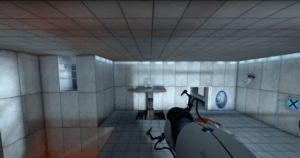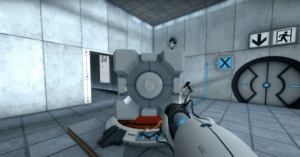For my critical play this week, I analyzed Portal (1). I’ve played the game before, but revisited it to refresh myself in advance of writing this analysis. In doing so, it became clear that the player’s experience is directly shaped by the key puzzle mechanics, and specifically the “portal gun.” In this analysis, I will argue that the portal gun acts as a gameplay device which allows Portal to subvert conventional expectations of space in level design, resulting in a novel puzzle-solving experience that makes the game simultaneously challenging and engaging. The gun allows players to bend the laws of physics by creating inter-spatial portals on flat surfaces. This also forces players to reassess their understanding of location and proximity within the game’s environment, turning traditional puzzle-solving on its head and making spatial reasoning the heart of the gameplay experience.
Puzzle games as a genre are perpetually trying to remain accessible and solvable while retaining their novelty and challenge. Portal approaches this problem by delving into the realm of non-linear puzzle solving (enabled by the portal gun’s spatial reshuffling) to reinvent the interactive/environmental class of puzzles. Creating a portal on one surface and exiting through another that could be positioned at a completely different angle or location challenges our assumptions of physics and forces players to think about their resources in non-linear ways.
My personal journey through Portal 1 illustrated how the portal mechanic is a powerful tool in shaping the gameplay. In one level, I faced a room with companion cubes on inaccessible platforms, cube-triggered buttons in other places, and no clear indication of how to proceed. I noted that in other puzzle games, such a setup would be indicative of a solution that involves intricate platforming or finding a bridge. However, the presence of the portal gun allowed me to think differently about the level space. I was able to place portals and carry cubes through them to trigger the buttons and clear the level. Crossing a portal is also an experience-altering action. It is simultaneously disorienting and exhilarating to manipulate how physics operates, turning a puzzle into a sequence of unconventional vertical traversals. Without this mechanic, Portal’s bare, gray research facility setting would quickly grow stale.


However, I would also note that this aspect of the game could be further improved by making the puzzle solutions more flexible. My favorite parts of my playthrough were when a puzzle seemed incredibly daunting on first glance – one such puzzle that stands out had a sequence of fast moving platforms that seemed to demand dexterous jumps for horizontal traversal. However, after trying this a couple of times, I realized I was able to bypass the puzzle altogether through clever use of portals. The satisfaction in doing so indicated that having a large solution space for puzzles, with a more obscure but simultaneously more elegant optimal solution, makes players feel more intellectually empowered when playing an already mentally stimulating game.
Secondary to this improvement, I think the game could take its physics-bending mechanics further. Just like how you’re able to conserve momentum through portals to launch companion cubes, I think it would be interesting to see how the spatial reimagination of Portal would interact with things like fluid dynamics and light refraction (although the latter is explored somewhat already). Doing so would further the extent to which players need to think non-linearly to solve game puzzles, which would create a richer gameplay experience. In a similar vein, I think having the ‘levels’ (test rooms, as they are referred to in-game) be more sandbox-like would make them feel more malleable to different puzzle-solving styles, and make the player feel like they have more agency in charting a path through the game’s challenges.
As a whole, I also found that Portal’s approach to unconventional puzzle design left me with important takeaways for the puzzles we are hoping to implement into our own game. In our case, our puzzles are currently more of a narrative vehicle than core mechanic, but I think the way Portal’s puzzles engage players through their unconventional nature holds valuable lessons. One key tool Portal employs is the layering of environmental variables – triggering buttons at one point in the game can have knock-on effects in later stages, and multi-layered levels often require players to solve multiple puzzles using the same environmental resources. I think this could be a very efficient way for us to make our puzzles more engaging – keeping their core challenge as is, but requiring players to utilize more components in our levels to solve them.
In conclusion, Portal 1’s portal mechanic is more than a tool within the game; it is the core game mechanic that defines player experience. It challenges players to think differently about space, provides a sense of achievement through unconventional problem-solving, all while supporting the game’s narrative themes of control and defiance. The mechanic’s ability to subvert traditional expectations of space transforms how players interact with and perceive the game world, making it an essential part of the rich game experience Portal offers.



